Mineral is a naturally occurring crystalline solid with a definite composition. There are almost 5,000 minerals described so far2. Trying to familiarize ourselves with all of them would be a hopeless task. Luckily, this is not necessary if our goal is to understand how our home planet works and what is it made of.
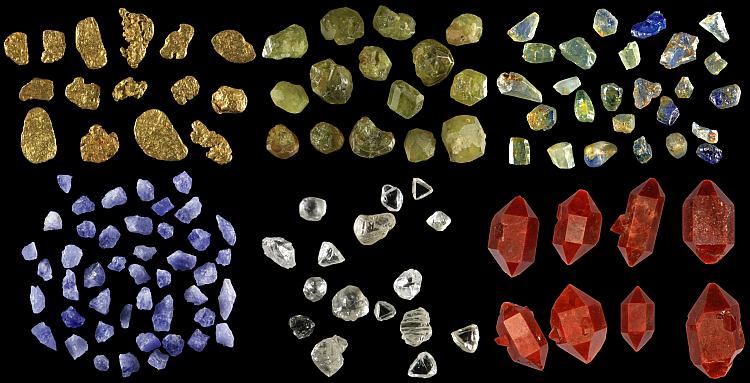
Mineral grains of gold, garnet (andradite), corundum, sodalite, diamond, and quartz.
About 200 minerals are called the rock-forming minerals. These are the minerals that are listed and described below. More than 99.9% of the Earth’s crust is composed of these minerals. This list of minerals and specific articles about each mineral species are all focused on minerals as they naturally occur within rocks and sediments.
http://picasaweb.google.com/107509377372007544953/Rocks#5803259907176294146
More than 90% on the crust is composed of silicate minerals. Most abundant silicates are feldspars (plagioclase (39%) and alkali feldspar (12%)). Other common silicate minerals are quartz (12%) pyroxenes (11%), amphiboles (5%), micas (5%), and clay minerals (5%). The rest of the silicate family comprises 3% of the crust. Only 8% of the crust is composed of non-silicates — carbonates, oxides, sulfides, etc1.
1. Silicates
Silicates are minerals that contain SiO4 tetrahedra in their crystal structure.
1.1 Framework silicates (tectosilicates)
This is volumetrically the most important group of silicate minerals. More than two thirds of the crust is composed of framework silicates. Each oxygen ion of the SiO4 tetrahedron is shared with another tetrahedron. Hence, three-dimensional framework forms which gives name to the group. Si:O ratio in silicon tetrahedra is 1:2 or 0.50 (Si may be replaced with Al. In this case Si=Si+Al).
1.1.1 Silica group
Minerals that belong to this group share the same chemical composition — SiO2. By far the most important mineral in this group is quartz.
| http://picasaweb.google.com/107509377372007544953/250#6189243886766112354 | Quartz Composition: SiO2 Occurrence: Very abundant (12% of the crust) and widespread. Occurs in many igneous, metamorphic, and sedimentary rocks. Quartz is the principal component of most sand samples. Uses: Numerous industrial uses. Raw material in glass-making and a source material for elemental silicon used in semiconductors. Quartz as the most important sand mineral finds extensive use in the construction industry. |
1.1.2 Feldspar group
Feldspars are the most abundant minerals in the crust. There are two subgroups: alkali feldspars and plagioclase feldspars. Alkali feldspars are usually Potassium-rich. Hence, they are often named K-feldspars (orthoclase, microcline, and sanidine belongs to this group). Plagioclase feldspars form a solid solution between Na- and Ca-rich end-members.
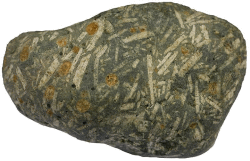 |
Plagioclase Composition: NaAlSi3O8-CaAl2Si2O8 (solid solution between Na and Ca end-member) Occurrence: The most common mineral group in the crust. It is a major component in basalt, gabbro, and many granitoids. Plagioclase is also very common in metamorphic rocks but compared with its abundance in the hard rocks, it is relatively underrepresented in sedimentary rocks. Plagioclase may be abundant in sand and sedimentary rocks but it is not as common there as K-feldspar because its resistance to weathering processes is not as good. Uses: Mostly used in the construction industry but not because of some specific property but simply because it is a major component of many hard rocks suitable for aggregate-making. Plagioclase-bearing rocks are often used as dimension stones, especially valued are rocks that contain iridescent plagioclase varieties. Plagioclase (Ca-rich end-member) could potentially be a source of aluminum but bauxite mining is more economical way to obtain this metal. |
| http://picasaweb.google.com/107509377372007544953/RockTypes100#5852683860844135714 | Orthoclase Composition: (K,Na)AlSi3O8 Occurrence: A very common mineral in felsic igneous rocks like granite, syenite, granodiorite and also in metamorphic rocks (schist, gneiss). Orthoclase is also common in clastic sedimentary rocks. Its color is variable, usually pink, yellow, gray. Orthoclase is difficult to distinguish from microcline (they are dimorphous — having the same chemical composition but different crystal symmetry). Orthoclase dominates in younger (Phanerozoic) intrusives. Microcline occurs more often in deep-seated magmatic intrusives. Uses: K-feldspar just as plagioclase is used in construction industry as aggregate and also as a major part of many dimension stones, especially granite. Orthoclase is used as filler in paints, plastic and rubber. K-feldspar is also used in the ceramics industry. Alumina from feldspars improves durability and hardness of glass and improves its resistance to chemical corrosion. K-feldspar is also used as a flux which lowers the melting temperature of ceramic mixtures or glass. |
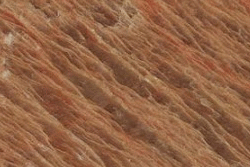 |
Microcline Composition: (K,Na)AlSi3O8 Occurrence: A common mineral in granite and high-grade metamorphic rocks. Microcline occurs in rocks that formed deep in the crust. It is absent in volcanic rocks. Uses: Orthoclase and microcline have similar properties. They are used the same way. |
1.1.3 Feldspathoid group
Feldspathoids are minerals that somewhat resemble feldspars and usually form instead of feldspars if there is not enough silica available. Compared to feldspars, feldspathoids are relatively rare minerals.
| http://picasaweb.google.com/107509377372007544953/RockTypes100#5852683647468879714 | Sodalite Composition: Na8Al6Si6O24Cl2 Occurrence: Sodalite can be considered a mineral group that also includes haüyne and nosean. Sodalite group minerals occur mostly in silicon-deficient, sodium-rich igneous rocks but also in some contact metamorphosed carbonate rocks. Uses: Beautiful blue color makes sodalite-bearing rocks valuable as dimension stones. |
1.2 Sheet silicates (phyllosilicates)
An important group of minerals, especially within the topmost 20 kilometers of the crust. All sheet silicates are hydrous. That’s why they are important in the upper part of the crust. There is too high pressure for them in the lower crust — water gets pushed out of the crystal structure. Silicon tetrahedra are joined to form parallel sheets. Si:O ratio is 2:5 (0.40).
1.2.1 Serpentine group
Serpentine group minerals are an alteration products of olivine and pyroxene (ultramafic rocks).
| http://picasaweb.google.com/107509377372007544953/RockTypes100#5846350400220615682 | Chrysotile Composition: Mg3Si2O5(OH)4 Occurrence: Chrysotile occurs in hydrothermally altered ultramafic rocks. Asbestiform chrysotile veins are cutting serpentinite rock that is mostly composed of the other two serpentine group minerals antigorite and lizardite. Uses: Chrysotile is the most widely used (98%) asbestos mineral. It is not anymore used as frequently as before because of alleged health risks. |
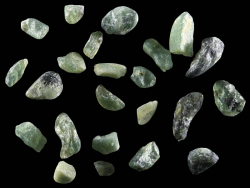 |
Antigorite & lizardite Composition: Mg3Si2O5(OH)4 Occurrence: Antigorite and lizardite are described in the same article because these minerals are macroscopically indistinguishable. They occur together with chrysotile in hydrothermally altered Mg-rich ultramafic rocks. Antigorite and lizardite also occur in contact metamorphosed carbonate rocks (skarns). Uses: No significant uses. |
1.2.2 Mica group
Micas comprise about 4% of the crust.
| http://picasaweb.google.com/107509377372007544953/RockTypes100#5852683828512353570 | Muscovite Composition: KAl2(AlSi3O10)(OH)2 Occurrence: Muscovite is a common mineral found in many rock types. Muscovite is common in Al-rich igneous rocks like granite and pegmatite. Muscovite, especially as a fine-grained sericite, is widespread in metamorphic rocks like schist, slate, gneiss, etc. Muscovite is also common in clastic sediments and sedimentary rocks. Uses: Muscovite has many uses. It has been used as a substitute of window glass. Nowadays it is used more often in pulverized form in cosmetic products, for example nail polishes. Its purpose is to add silky luster. It has the same role as a filler in plastics, paint and wallpaper coatings. Muscovite is an important industrial mineral that is used in insulators, transistors and capacitors. |
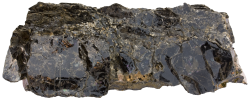 |
Biotite Composition: K(Fe,Mg)3AlSi3O10(OH)2 Occurrence: Widespread mineral in many rock types. It is a main iron-bearing silicate in felsic igneous rocks and metamorphic rocks with similar composition (schist, gneiss). Mg-rich variety phlogopite is common in ultramafic and metamorphosed carbonate rocks. Biotite occurs in clastic sediments also but it is not as common there as muscovite because of poorer resistance to weathering. Uses: Biotite itself is not nearly as widely used as is muscovite but vermiculite which is an alteration product of biotite has many uses. It is used as a filler, insulation material and it is an additive in potting soil. |
| http://picasaweb.google.com/107509377372007544953/RockTypes100#5852683787021334642 | Glauconite Composition: (K,Ca,Na)1.6(Fe3+,Al,Mg,Fe2+)4Si7.3Al0.7O20(OH)4 Chemical composition of glauconite is very complex because of numerous possible replacements. Occurrence: Glauconite is a green-colored mineral (it shares characteristics of both micas and clay minerals) found mostly in marine sandstones. Uses: Glauconite is mainly used in water purification to remove soluble iron, manganese and hydrogen sulfide. It is also added to soil to improve its properties: acts as a potassium source and loosens clayey soil. |
1.2.3 Chlorite group
There are many chlorite group minerals which are generally indistinguishable from each other by their physical and optical properties. Sometimes chlorite is included in the clay minerals group but I decided to keep it separately because chlorite is also an important metamorphic mineral which clay minerals are not.
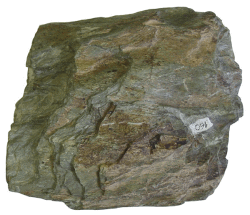 |
Chlorite Composition: (Mg,Fe,Al)3(Si,Al)4O10(OH)2·(Mg,Fe,Al)3(OH)6 Occurrence: Chlorite group minerals are generally green in color and occur mostly in low- or medium-grade mafic or pelitic metamorphic rocks (greenstone, chlorite schist) or in soil as a weathering product of mafic minerals. Uses: Chlorite as a mineral separately from others have no specific uses. But as a common mineral it is an ingredient in clay and also in chlorite schist which may find use as a building material. |
1.2.4 Clay minerals
These minerals are so fine-grained that you have no hope to see individual crystals with a naked eye. They are very important for us because they occur in the upper parts of the crust and are widespread (think about mud which is in large part composed of clay minerals). Clay minerals are weathering products of other silicate minerals.
| http://picasaweb.google.com/107509377372007544953/RockTypes100#5852684059912520994 | Clay minerals Composition: Al2SiO2O5(OH)4 (kaolinite). Composition of clay minerals is variable and very complicated because of numerous substitutions. The fact that we do not have an agreement what actually is a clay mineral and which minerals should we include into this group does not make things easier. Occurrence: Clay minerals are disintegration products of other minerals. They occur wherever there is moisture-driven weathering. Clay minerals form a major part of sedimentary rocks, especially mudstone and shale. Uses: Clay minerals have enormous range of possible uses. Clay is used to make bricks, cement, ceramics. It is used as a filler in paper, plastics, paint, rubber, etc. Clay has also been used in cosmetics, pharmaceuticals and even food. |
1.2.5 Other sheet silicates
| http://picasaweb.google.com/107509377372007544953/RockTypes100#5852683819837569650 | Talc Composition: Mg3Si4O10(OH)2 Occurrence: Talc is a metamorphic mineral. It is an alteration product of Mg-rich rocks (mostly serpentinite and impure dolostone). Talc is a major component in soapstone (named so because talc gives it soapy feel when touched) and talc schist. Uses: Talc has many uses. It is used in various cosmetic/medical products like lipsticks, baby powder, antiperspirant sticks, etc. It is also used industrially as a filler in paper, plastics and rubber. |
Rare sheet silicates I have written about: zinnwaldite.
1.3 Chain silicates (inosilicates)
Chain silicates are common minerals in mafic igneous (especially pyroxenes) and metamorphic (especially amphiboles) rocks. Their structure is composed of many parallel chains (double chains in amphiboles) of silicon tetrahedra. That’s why the crystals of chain silicates tend to be elongated. Pyroxenoids are relatively scarce minerals that are structurally similar to pyroxenes. Si:O ratio is 1:3 (pyroxenes and pyroxenoids) or 4:11 (amphiboles) (0.33 or 0.36).
1.3.1 Pyroxene group
| http://picasaweb.google.com/107509377372007544953/RockTypes100#5852684110177272482 | Augite Composition: (Ca,Mg,Fe2+,Fe3+,Al)2(Si,Al)2O6 Occurrence: Augite is the most common pyroxene. Augite occurs mostly in mafic igneous rocks like gabbro and basalt but it is also found in some metamorphic rocks like granulite and amphibolite. Uses: Augite itself has no uses but rocks containing it are frequently used as dimension stones or as a raw material for construction idustry. |
| http://picasaweb.google.com/107509377372007544953/250#6192124946857339330 | Diopside Composition: CaMgSi2O6 Occurrence: Diopside occurs mostly in ultramafic igneous rocks and calc-silicate metamorphic rocks (skarn). Uses: Beautiful crystals (colorless and intensely green chromian diopside crystals) are semi-precious gemstones. Diopside is used in dental ceramics. |
| http://picasaweb.google.com/107509377372007544953/RockTypes100#5852683911045629346 | Spodumene Composition: LiAlSi2O6 Occurrence: Only in lithium-rich pegmatites where it may be associated with lepidolite, tourmaline and beryl (in addition to quartz and feldspar). Uses: Spodumene is mined as a source of lithium although lithium is mostly obtained from other sources (brines). |
1.3.2 Pyroxenoid group
Pyroxenoids are relatively rare minerals when compared with pyroxenes. The difference between them is that the chains of pyroxenoids are twisted or distorted while they are straight in pyroxenes. Common pyroxenoid minerals are wollastonite, rhodonite and pectolite.
| http://picasaweb.google.com/107509377372007544953/250#6222515783375616274 | Wollastonite Composition: CaSiO3 Occurrence: Wollastonite is found in metamorphosed limestone. It is a result of chemical reaction between silicate and carbonate minerals. Uses: Wollastonite has a number of industrial uses. It is a flux in metallurgy, filler in plastics, and it is also used as a replacement to asbestos. |
1.3.3 Amphibole group
Amphiboles are common minerals in metamorphic rocks (amphibolite, glaucophane schist) and some igneous rocks (especially diorite). Amphiboles are hydrous minerals. Therefore, amphiboles are not stable in anhydrous and high-temperature conditions where they tend to transform to pyroxenes.
| http://picasaweb.google.com/107509377372007544953/RockTypes100#5852683920221531442 | Hornblende Composition: (Na,K)0-1Ca2(Mg,Fe2+,Fe3+,Al)5(Si,Al)8O22(OH)2 The chemical composition of hornblende is interesting because it contains all eight chemical elements that are most abundant in the Earth’s crust (O, Si, Al, Fe, Ca, Na, K, Mg). Occurrence: Hornblende is not a single mineral. It is the most abundant mineral group within amphiboles. Hornblende occurs in many igneous (diorite, andesite, granitoids) and metamorphic rocks (amphibolite, hornblende gneiss). Uses: Hornblende itself has no uses but rocks containing it are widely used as dimension stones and as a raw material for construction industry. |
| http://picasaweb.google.com/107509377372007544953/RockTypes100#5852683923935573650 | Glaucophane Composition: Na2Mg3Al2Si8O22(OH)2 Occurrence: Glaucophane is a major mineral in high-pressure low-temperature metamorphic rocks known as blueschists. Associated minerals include chlorite, pumpellyite, albite, epidote, jadeite, and quartz. Uses: None. |
| http://picasaweb.google.com/107509377372007544953/250#6205945048173950034 | Riebeckite Composition: Na2Fe2+3Fe3+2Si8O22(OH)2 Occurrence: Riebeckite is found in alkaline igneous rocks like nepheline syenite, alkali granite, syenite. Crocidolite is a fibrous (asbestiform) variety of riebeckite which is found in metamorphosed ironstones. Uses: Riebeckite variety crocidolite (blue asbestos) has been mined and used as an asbestos in the past but nowadays in most countries it is not used anymore because of health concerns. “Tiger’s eye” is a chatoyant gemstone composed of pseudomorphous quartz after crocidolite. |
1.4 Disilicates (sorosilicates)
The structural element that defines this group is a double silicon tetrahedron that looks like a bow tie (two tetrahedrons share the same oxygen ion). There are not too many disilicates but they tend to resist weathering quite well and are therefore often abundant in sand. Si:O ratio is 2:7 (0.29).
1.4.1 Epidote group
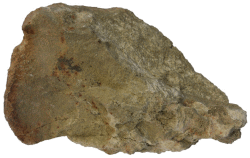 |
Epidote Composition: Ca2Al2(Al,Fe3+)OOH[Si2O7][SiO4] Occurrence: Epidote is the most abundant disilicate. Epidote occurs mostly in metamorphic rocks. It is common in hydrothermal zones. Especially common is epidotic alteration along faults and fractures between rocks. Epidote is also a common mineral in sand. Uses: It is a semiprecious gemstone (both as a crystal and as a fine alteration of granitic rocks known as unakite). No industrial uses. |
1.5 Ring silicates (cyclosilicates)
A small group of minerals that contain 6-fold rings of silicon tetrahedra that are on top of each other to form columns. Si:O ratio is 1:3 (0.33).
| http://picasaweb.google.com/107509377372007544953/RockTypes100#5852684081650785298 | Beryl Composition: Al2Be3Si6O18 Occurrence: Beryl occurs mostly in granitic pegmatites where it may form beautiful crystals. It occurs less commonly in granites and syenites. Beryl may be found in high-temperature hydrothermal systems. Uses: Beryl is the principal source of beryllium. Beryl is a valued gemstone (emerald and aquamarine). |
1.6 Orthosilicates (nesosilicates)
Silicon tetrahedra are isolated from each others in orthosilicates. Orthosilicates is a diverse and widespread group of minerals. Si:O ratio is 1:4 (0.25).
1.6.1 Garnet group
There are two subgroups of garnets: pyralspites and ugrandites. Pyralspites (pyrope, almandine, spessartine) are reddish and occur in aluminum-rich metamorphic rocks or igneous rocks. Ugrandites (uvarovite, grossular, andradite) are brownish and occur mostly in calc-silicate rocks.
| http://picasaweb.google.com/107509377372007544953/RockTypes100#5852684158599316130 | Pyrope Composition: Mg3Al2(SiO4)3 Occurrence: Pyrope is a garnet that occurs in Mg-rich ultramafic rocks and serpentinites (metamorphosed ultramafic rocks). Uses: Pyrope is a semiprecious gemstone. |
| http://picasaweb.google.com/107509377372007544953/RockTypes100#5852684046517004802 | Almandine Composition: Fe3Al2(SiO4)3 Occurrence: Almandine is the most common garnet. It occurs in both metamorphic (schist, amphibolite, gneiss, granulite) and igneous rocks (Al-rich granites) although garnet in igneous rocks may be spessartine (Mn-garnet). Almandine is a very common heavy mineral in clastic sediments. Uses: Almandine is used as an abrasive and in filters in water purification plants. Almandine is a semiprecious gemstone. |
| http://picasaweb.google.com/107509377372007544953/RockTypes100#5852683658500122818 | Andradite Composition: Ca3Fe23+(SiO4)3 Occurrence: Andradite is the most common garnet in skarns where it is associated with calcite and other Ca-silicates (diopside, wollastonite, epidote, tremolite, etc.). Uses: Andradite is a semiprecious gemstone. Melanite is a dark titanian variety of andradite which is perhaps more widely known among mineral collectors than andradite itself. |
1.6.2 Aluminum silicates
Aluminum-silicates andalusite, kyanite, and sillimanite share the same composition but differ structurally. They are metamorphic minerals that transform from one form to another with changing pressure and temperature.
| http://picasaweb.google.com/107509377372007544953/250#6196311887864011682 | Andalusite Composition: Al2SiO5 Occurrence: Andalusite is a low-pressure and -temperature polymorph of aluminum silicates. Andalusite is a common mineral in hornfels and aluminum-rich (pelitic) schists. Uses: Andalusite is heated to convert it to a refractory material mullite which is used to make high-alumina heat-resistant bricks used in blast furnaces and kilns. |
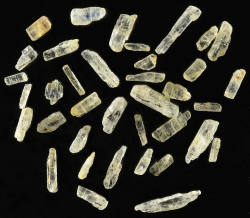 |
Kyanite Composition: Al2SiO5 Occurrence: Kyanite is a high-pressure polymorph of aluminum-silicates. It occurs mostly in aluminum-rich (pelitic) metamorphic rocks. Uses: Kyanite is used to produce mullite just as andalusite. Blue bladed kyanite crystals are attractive and have the most appeal to people of the three Aluminum silicate polymorphs. |
1.6.3 Other orthosilicates
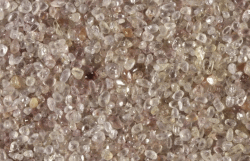 |
Zircon Composition: ZrSiO4 Occurrence: Zircon is widely distributed in igneous rocks but usually it occurs in very small crystals. Zircon is highly resistant to weathering and alteration which makes it common mineral in sediments and metamorphic rocks. Most of the mined zircon comes from placer deposits. Uses: Zircon is a principal source for zirconium and hafnium (small amount of zirconium is replaced by hafnium in the lattice of zircon). It is also an industrial mineral because its resistance to heat is very good. It is used in the manufacture of foundry sand and refractory bricks. Zircon is an especially useful mineral in geological research. Zircon is also used as a gemstone. |
| http://picasaweb.google.com/107509377372007544953/RockTypes100#5852684115168536306 | Staurolite Composition: Fe2Al9O6[(Si,Al)O4]4(OH)2 Occurrence: In medium-grade Al-rich metamorphic rocks. It is a major mineral in staurolite schist. Associated minerals are muscovite, garnet, chloritoid, cordierite, biotite and aluminum silicates. Staurolite is very common heavy mineral in clastic sediments where it can be misidentified as garnet. Uses: Staurolite is used as an abrasive. Often together with garnet. Twinned crystals have appeal to people because they resemble crosses. |
| http://picasaweb.google.com/107509377372007544953/RockTypes100#5852683778030548370 | Olivine Composition: (Mg,Fe)2SiO4 Occurrence: Mg-rich olivine is a common mineral in mafic and especially ultramafic rocks. Dunite is almost monomineralic olivine rock. Metamorphosed carbonate rocks may also contain forsterite. Fayalite (Fe-rich olivine) occurs in more felsic igneous rocks like some granites, syenites, volcanic rocks and iron-rich metasedimentary rocks. Uses: Olivine (peridot) ia a semiprecious gemstone. Olivine is used predominantly in metallurgy as a slag conditioner. Olivine is a hard mineral sometimes used as an airblast abrasive. It is a replacement to silica because of reduced risk of developing silicosis. Mg-rich olivine is used in dental ceramics to add strength. |
| http://picasaweb.google.com/107509377372007544953/RockTypes100#5852683834159393186 | Chloritoid Composition: (Fe2+,Mg,Mn)2(Al,Fe3+)Al3O2(SiO4)2(OH)4 Occurrence: Chloritoid occurs in low- to medium-grained metamorphic rocks, especially schists, phyllite and quartzite. It is associated with garnet, chlorite, Al-silicates, muscovite, and staurolite. Chloritoid may be easily misidentified as chlorite. Uses: No uses. |
| http://picasaweb.google.com/107509377372007544953/RockTypes100#5852684162227253042 | Topaz Composition: Al2SiO4(F,OH)2 Occurrence: Topaz is found in felsic igneous rocks. Large crystals may be found in pegmatites along with other minerals hosting incompatible chemical elements. Topaz also occurs in hydrothermal systems where it may be associated with tin, tungsten and molybdenum minerals. Topaz occurs in clastic sediments but is easily overlooked. Uses: Topaz is used as a gemstone. |
2. Carbonates, sulfates, phosphates, and borates
These minerals are classified according to anionic groups: CO32- (carbonates), SO42- (sulfates), PO43- (phosphates), etc.
2.1 Carbonates
Carbonates are an important group of minerals that are most widespread in sedimentary environments, evaporite deposits, and hydrothermal veins. These are environments where carbon dioxide is generally available to form the fundamental building block of carbonate minerals — the carbonate ion.
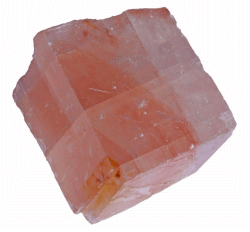 |
Calcite Composition: CaCO3 Occurrence: Calcite is a very common mineral, especially in sedimentary environments. Calcite is the principal component of limestone which includes travertine, chalk, tufa, etc. Calcite is a common cementing mineral in clastic sediments. Calcite is a very important biomineral but some of it formed by chemical precipitation (travertine, oolite). Calcite is a common vein-filling mineral in hydrothermal systems. It is common also in metamorphic rocks. Limestone recrystallizes at higher temperature and pressure (crystals grow larger) but does not alter into another phases, unless there is a significant input of new material (metasomatism) or the carbonate rock was impure. In these cases calcite is the source material of new calcium-bearing silicate minerals which form rock type known as skarn. Skarns also typically contain calcite. Calcite is a major mineral in evaporite deposits. Calcite may sometimes crystallize directly from magma. Carbonatite is a rare igneous rock where calcite is the dominant mineral. Uses: Calcite is a major industrial mineral. It is a raw material of cement and quicklime. Calcite or its products are used in steel and paper industries. It is also used to alter soil pH, treat wastewater, and in many other areas. Calcite is a very important biomineral. Calcium in the pills is in the form of calcite. Calcite as a primary constituent of marble is widely used as a dimension stone. |
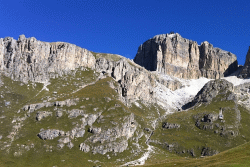 |
Dolomite Composition: CaMg(CO3)2 Occurrence: Dolomite occurs mostly in dolomite rocks (dolostones) which were originally limestone formations but their composition has been altered by Mg-bearing groundwater. Dolomite is a common mineral in hydrothermal veins. Metamorphic rocks also contain dolomite. Marble may be wholly or partly composed of it. Dolomite is present in some skarn deposits and also in rare igneous rocks carbonatites. Uses: Dolomitization produces porespace in the rock body which makes dolomite rocks potential reservoirs for groundwater and hydrocarbons (oil and gas). Other than that, dolomite has roughly the same uses as calcite does. It is also used in wasterwater treatment and in the manufacture of portland cement. MgO from dolomite is used in refractories. Dolomite is used in agriculture to improve soil properties and also as a feed additive. Dolomite rock is a frequently used dimension stone which is more resistant to weathering than calcitic limestone. |
| http://picasaweb.google.com/107509377372007544953/RockTypes100#5852683800875714610 | Magnesite Composition: MgCO3 Occurrence: Magnesite is a magnesium carbonate. Not nearly as common as dolomite and calcite but is occurs in various environments. Usually together with serpentine in metamorphosed ultramafic rocks but also in carbonate sedimentary rocks where dolomite is replaced by magnesite. Uses: Magnesite is a potential ore of magnesium but currently magnesium is extracted from brines and seawater. Magnesite is used to produce magnesium oxide (magnesite is heated for that) which is used in the manufacture of refractory materials. |
| http://picasaweb.google.com/107509377372007544953/RockTypes100#5852683847722341458 | Malachite Composition: Cu2CO3(OH)2 Occurrence: Malachite is a green copper-bearing hydrated carbonate mineral. It occurs near the surface in the oxidized part of hydrothermal copper sulfide mineral deposits. Malachite typically occurs with intensely blue copper-bearing mineral azurite. Malachite is usually an alteration product of chalcopyrite. Uses: Malachite is a minor ore of copper. Better known is its use as a semiprecious gemstone because of bright green color and attractive growth patterns in the crystals. |
2.2 Sulfates
Most sulfates occur in evaporite deposits (gypsum, for example) or hydrothermal veins (barite).
| http://picasaweb.google.com/107509377372007544953/RockTypes100#5852683950556527554 | Gypsum Composition: CaSO4·2H2O Occurrence: Gypsum is a common marine evaporite mineral. It is often associated with other evaporites like halite and sylvite. Gypsum is also found in desert soil as an efflorescence (migration of salty water to the surface where the water evaporates, leaving a coating of salts, including gypsum). Gypsum may precipitate around fumaroles in volcanically active areas. Uses: Most of the gypsum goes to construction industry (gypsum wallboards). Gypsum is used in the cement production and as a soil amendment. Well-known are gypsum casts for broken bones. |
| http://picasaweb.google.com/107509377372007544953/RockTypes100#5852684089708264674 | Barite Composition: BaSO4 Occurrence: Barite occurs as concretionary masses in sedimentary rocks or as a gangue mineral in hydrothermal deposits often together with sulfides like pyrite, galena and sphalerite. Uses: Barite is the main source of barium but the bulk of the mineral is used as an industrial mineral. Barite is unusually dense mineral and used in applications that take advantage of this property. In oil & gas industry barite is used as an ingredient of drilling mud. Barite-containing mud is pumped into the drill stem to prevent gas and other fluids from entering the wellbore during drilling operations. Barite is also used in medicine. |
| http://picasaweb.google.com/107509377372007544953/250#6221849563306647026 | Celestine Composition: SrSO4 Occurrence: Celestine is usually found in cavities in dolomites and dolomitic limestone. It also occurs in hydrothermal veins and in evaporite deposits. Uses: Celestine is a principal source of strontium which is mostly used in pyrotechnics. |
2.3 Phosphates
Phosphates are widespread although not very abundant minerals because phosphorous comprises only 0.1% of the Earth’s crust.
| http://picasaweb.google.com/107509377372007544953/RockTypes100#5852684150304454562 | Monazite Composition: (Ce,La,Th)PO4 Occurrence: Monazite is an accessory mineral in felsic igneous rocks like granite, pegmatite, and syenite. It is also found in some metamorphic rocks (gneiss, mica schist, metamorphosed dolomite). Monazite is resistant to weathering and is therefore frequently present in sand. Uses: Monazite is an important source of thorium, cerium and other rare earth elements (REE) which have numerous industrial applications. Thorium, for example, has been used as a fuel in nuclear reactors. Monazite is mostly extracted from sand (placer deposits). |
2.4 Borates
Borates are almost exclusively evaporite minerals found in saline lakes. Borate minerals are not found in regions with wet climate because they are moderately soluble in water.
| http://picasaweb.google.com/107509377372007544953/RockTypes100#5852683970934168738 | Ulexite Composition: NaCaB5O6·5H2O Occurrence: Ulexite is found in saline lakes with other evaporite minerals. Most notable localities of beautiful crystals are California, Chile, and Kazakhstan. Uses: Ulexite is a source of boron which has many industrial uses. |
3. Oxides, hydroxides, and halides
These minerals are grouped together because they all have so-called simple anions.
3.1 Oxides
Oxides are compounds of oxygen and one or more metal cations. Oxygen is the most abundant chemical element in the crust but much of it is already tied up in silicates (silicon is number 2 in abundance after oxygen). Oxides typically do not form the major part of rocks but they are very widely distributed. Rocks that contain high concentration of oxide minerals are possible metal ores.
3.1.1 Spinel group
Spinel group contains three subgroups or series: spinel series, magnetite series, and chromite series. They are all structurally similar but differ in composition. Each series has one important mineral that also gives name to the series. They are the minerals that are described below.
| http://picasaweb.google.com/107509377372007544953/RockTypes100#5852683793153946866 | Spinel Composition: MgAl2O4 Spinel is a colorful mineral that occurs mostly in metamorphic rocks. Spinel is relatively resistant to weathering. So, it is often found in sand. |
| http://picasaweb.google.com/107509377372007544953/RockTypes100#5852684140870169970 | Magnetite Composition: Fe3O4 Magnetite in the most abundant mineral of spinel group. It is found in many igneous and metamorphic rocks but also forms an important component of detrital sediments. |
| http://picasaweb.google.com/107509377372007544953/RockTypes100#5852684075989988722 | Chromite Composition: FeCr2O4 Chromite is the principal ore of chromium. It occurs mostly in ultramafic cumulate rocks. |
3.1.2 Other oxides
| http://picasaweb.google.com/107509377372007544953/RockTypes100#5852684093724038530 | Cuprite Composition: Cu2O |
| http://picasaweb.google.com/107509377372007544953/RockTypes100#5852683849534258258 | Hematite Composition: Fe2O3 |
| http://picasaweb.google.com/107509377372007544953/RockTypes100#5852683666577597698 | Corundum Composition: Al2O3 |
| http://picasaweb.google.com/107509377372007544953/RockTypes100#5852684136844417810 | Ilmenite Composition: FeTiO3 |
| http://picasaweb.google.com/107509377372007544953/RockTypes100#5852683843763790946 | Rutile Composition: TiO2 |
| http://picasaweb.google.com/107509377372007544953/RockTypes100#5852684063023295746 | Cassiterite Composition: SnO2 Cassiterite is an oxide of tin. It is the principal ore of tin. Cassiterite crystals have a strong luster and they are often twinned (elbow twins). |
3.2 Hydroxides
Hydroxides are common minerals that occur as fine-grained (earthy) aggregates which are often mixtures of several minerals. Limonite, for example, is not a distinct mineral species because it contains several fine-grained minerals, most of them hydroxides. Hydroxides are very common minerals in soil.
| http://picasaweb.google.com/107509377372007544953/RockTypes100#5852683975488015762 | Goethite Composition: FeO(OH) Occurrence: Goethite is a common brown-colored iron hydroxide that is an important weathering product of many iron-bearing minerals. Iron ooids in sedimentary rocks are mostly made of goethite. Goethite is a chief component of limonite. Uses: Goethite is among the primary constituents in some sedimentary iron ores (Lorraine basin in France). Bog iron, which used to be a significant source of iron in some regions, is largely composed of goethite. |
| http://picasaweb.google.com/107509377372007544953/RockTypes100#5847844860811014034 | Gibbsite Composition: Al(OH)3 Occurrence: Gibbsite, boehmite, and diaspore (all aluminum hydroxides) are common minerals in soil, but they are especially concentrated in certain lateritic rocks which had an aluminous protolith (bauxite). Bauxite forms in hot and humic climate. Lots of precipitations washes more soluble ions out of the weathered rock, leaving the rock enriched in aluminum-bearing hydrous phases. Uses: Bauxite is the principal source of aluminum. |
3.3 Halides
Halides are minerals where anion is one of the halogen elements (Cl, F, Br, I). Only three halides are common minerals. Halite and sylvite are very common evaporites and fluorite is a common hydrothermal mineral.
| http://picasaweb.google.com/107509377372007544953/RockTypes100#5852683830631991090 | Halite Composition: NaCl Occurrence: Halite is a common evaporite mineral and may form very thick salt deposits. Every liter of seawater with average salinity contains 35 grams of dissolved halite. Halite is a major component of salt diapirs which rise buoyantly from deeply buried salt deposits. Halite is associated with gypsum, sylvite, dolomite, and calcite. Uses: Halite is well known as an ordinary table salt. However, this is not the only and even the most important use of it. Halite is mostly used as a raw material in the chemical industry. It is also used to keep roads ice-free during winter. |
| http://picasaweb.google.com/107509377372007544953/RockTypes100#5852683991238977986 | Sylvite Composition: KCl Occurrence: Sylvite is an evaporite mineral like halite but requires much more evaporation than does halite. Associated minerals are gypsum, halite, dolomite, calcite, and anhydrite. Uses: Sylvite is primarily used to make potassium-releasing fertilizers. |
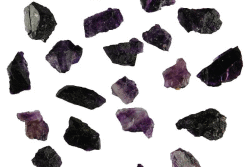 |
Fluorite Composition: CaF2 Occurrence: Fluorite is a mineral precipitated from hydrothermal fluids. Fluorite is usually associated with sulfides, barite, and carbonates. Fluorite is an accessory mineral in late-magmatic felsic rocks like granite, syenite, and especially pegmatite. Greisen is also usually rich in fluorite. Fluorite may be a cementing mineral in sandstones and occur in clastic sediments. Uses: Fluorite is the principal source of fluorine which has numerous industrial applications. |
4. Sulfides
Sulfides is a very large mineral group (nearly 600 minerals). Only few sulfides are really abundant but many of them are important ore minerals. Sulfides occur mostly in hydrothermal veins.
| http://picasaweb.google.com/107509377372007544953/RockTypes100#5852683806692938466 | Chalcopyrite Composition: CuFeS2 Occurrence: Chalcopyrite usually occurs with other sulfide minerals in hydrothermal systems. Chalcopyrite is the most common copper-bearing mineral and it is the primary source of copper. Chalcopyrite is sometimes found in mafic igneous rocks as an accessory phase. Uses: Chalcopyrite is the principal source of copper. It is usually mined from porphyry copper deposits. Chalcopyrite in these rocks is hydrothermal. The copper-bearing fluids originate from porphyritic felsic plutons. |
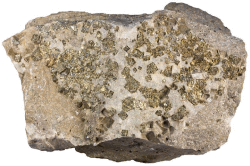 |
Pyrite Composition: FeS2 Occurrence: Pyrite is the most abundant sulfide mineral. Pyrite is found in hydrothermal veins, igneous rocks (as an accessory mineral), some metamorphic rocks, and sedimentary rocks as well (slate, coal, etc.). Pyrite is also an important biomineral, it is often formed in biologically controlled processes. Uses: Pyrite in most cases is not useful at all. It is an undesired addition to other minerals deemed more worthy of mining. Pyrite is a nuisance in these cases because it disintegrates rapidly in the weathering environment. This process releases heat which can lead to the combustion of dumps containing oil shale, for example. And even more importantly, the disintegration process releases sulfuric acid which is harmful to the environment. However, pyrite has been mined as a source of iron and sulfur and some deposits contain inclusions of gold in pyrite crystals. |
| http://picasaweb.google.com/107509377372007544953/RockTypes100#5852683997906316546 | Marcasite Composition: FeS2 Occurrence: Marcasite is a common mineral in low-temperature hydrothermal systems. It is often associated with galena and sphalerite. Marcasite may also form as a result of supergene processes. Marcasite concretions occur in coal, limestone and shale. Fossils in these rocks may be pseudomorphically replaced by marcasite. Uses: Marcasite is not particularly useful. It may be mined with other more important sulfide minerals. Theoretically marcasite could be a source of sulfur and iron, but we have better alternatives for them. |
| http://picasaweb.google.com/107509377372007544953/250#6222495980557083010 | Orpiment Composition: As2S3 Occurrence: Orpiment precipitates out of volcanic gases or from hot springs and low-temperature hydrothermal solutions. Uses: It has been used countless times as a poisoning agent. Nowadays it has more industrial uses. It is used in the production of fireworks, semiconductors, linoleum, etc. |
5. Native elements
Native elements are rare in the crust. Graphite is the most common of them and forms sometimes significant parts of rocks. Other native elements are found in small quantities and they are often very valuable mineral resources.
5.1 Metals
Metals rarely occur as native elements.
| http://picasaweb.google.com/107509377372007544953/RockTypes100#5852683653129696658 | Gold Composition: Au Occurrence: Gold is usually found in hydrothermal sulfide deposits or in quartz veins in greenstones. Gold is commonly found in hydrothermal veins but it may be disseminated through a large volume of rock. Gold may be concentrated in alluvial sediments (placer gold) which used to be the type of deposit gold was extracted from. Nowadays gold is mostly extracted from rocks. Gold is also a biomineral. Several microbes are capable of extracting gold from solutions and precipitating it inside the cell. Uses: Gold is a very rare metal with significant monetary value. It has been used in jewelry and as a stable currency that can not be undermined by greed and stupidity because there is no way to quickly print new gold as is the case with paper money. Gold also has superior properties like electric conductivity and inertness. Gold is often used in electronics and in dentistry. |
| http://picasaweb.google.com/107509377372007544953/RockTypes100#5852684009497351026 | Copper Composition: Cu Occurrence: Native copper is not nearly as common as are copper-bearing minerals like sulfides and carbonates (chalcopyrite, bornite, malachite, etc.) but it may occur in mafic volcanic rocks. It forms when copper-bearing solution reacts with iron-bearing minerals and fills cracks in the rock body. Native copper sometimes occurs in oxidized copper-bearing hydrothermal systems. Uses: Copper is a major industrial commodity used mostly in electric wires. However, the copper used nowadays comes mostly from sulfide minerals because there is not enough native copper to satisfy the demand. |
5.2 Nonmetals
Sulfur and graphite are the most common non-metal native elements in the crust. Diamond is very rare. It is definitely no rock-forming mineral but I think it is appropriate to include it here because diamond is highly sought after jewel and important for industry because of its extreme hardness.
| http://picasaweb.google.com/107509377372007544953/RockTypes100#5852683797890907778 | Graphite Composition: C Occurrence: Graphite is a common mineral in some metamorphic rocks (graphite schist, slate, phyllite) that originally as sediments contained organic matter. Graphite also occurs in skarn, metamorphosed coal and marble. Graphite may infrequently crystallize from magma. Uses: Graphite is a widely used industrial mineral. The most well-known is the use of graphite in pencil “leads” where it is mixed with clay (adds hardness to soft graphite) and binder. Graphite is used as a dry lubricant. Graphite has numerous other industrial applications in electronics, auto industry, and metallurgy. |
| http://picasaweb.google.com/107509377372007544953/RockTypes100#5852683673180921474 | Diamond Composition: C Occurrence: Diamond formed in the Earth’s mantle because it needs very high pressure to form. It is mined from ultramafic kimberlite pipes which reached the surface by violent gas-charged eruptions. Kimberlite pipes are rarely seen on the surface as outcrops. Ultramafic rocks typically decay rapidly at the surface liberating diamonds with other characteristic mantle minerals as sand grains. These minerals include purple garnet pyrope and bright green pyroxene diopside which are easily spotted in the heavy mineral concentrate and hence are widely used when looking for new kimberlite pipes. Diamonds may also occur in rocks that have been rapidly metamorphosed by ultra-high pressure caused by impact events (meteorite explosions). Uses: Diamond is the hardest mineral which makes it valuable in cutting, drilling and polishing tools. Diamond is a highly valued gemstone. |
References
1. Klein, C., Hurlbut, C. S. (1993). Manual of Mineralogy, 21st Edition. John Wiley & Sons.
2. Commission on New Minerals, Nomenclature and Classification
3. Nesse, William D. (2011). Introduction to Mineralogy, 2nd Edition. Oxford University Press.
4. Deer, W. A., Howie, R. A. & Zussman, J. (1996). An Introduction to the Rock-Forming Minerals, 2nd Edition. Prentice Hall.
Website Slot Online Terpercaya untuk Kemenangan Mudah dengan Bonus Menarik dan Bocoran Togel Hari Ini di 2024
Di dunia permainan daring yang penuh warna, menemukan situs slot yang terpercaya kaisar303 dengan berbagai permainan dan bonus yang substansial dapat sangat meningkatkan pengalaman bermain Anda. Pada tahun 2024, pemain semakin mencari platform yang tidak hanya menawarkan beragam permainan slot tetapi juga peluang terbaik untuk menang. Berikut adalah panduan lengkap tentang apa yang membuat situs slot teratas di 2024, termasuk informasi Togel harian dan tips untuk memaksimalkan kemenangan Anda.
1. Meningkatnya Situs Slot Terpercaya
Seiring meningkatnya popularitas permainan daring, pemain semakin selektif dalam memilih tempat bermain. Berikut adalah faktor-faktor utama yang mendefinisikan situs slot yang terpercaya:
Lisensi dan Regulasi
Memilih situs mpo4d yang memiliki lisensi resmi, seperti yang diatur oleh otoritas terpercaya, memastikan lingkungan bermain yang aman. Pada tahun 2024, sekitar 75% pemain lebih memilih situs berlisensi untuk menghindari penipuan dan aktivitas curang.
Variasi Permainan
Koleksi permainan yang beragam sangat penting. Platform terbaik mpo4d slot menawarkan ratusan slot, mulai dari tema klasik hingga slot video inovatif. Sekitar 80% pemain mengatakan bahwa banyaknya pilihan permainan sangat mempengaruhi keputusan mereka dalam memilih situs permainan.
Pembaruan Rutin
Situs yang sering memperbarui perpustakaan permainan menjaga pengalaman tetap segar dan menarik. Sekitar 70% pengguna menghargai penambahan permainan baru setiap bulan, sehingga minat mereka tetap terjaga dan mendorong kunjungan yang sering.
2. Manfaat Bermain di Situs Slot Resmi Berkualitas
Bermain di platform mpo slot yang terkenal memiliki banyak manfaat yang meningkatkan perjalanan bermain Anda. Berikut adalah beberapa keuntungan signifikan:
Tingkat RTP yang Tinggi
Persentase return-to-player (RTP) sangat penting saat memilih permainan slot. Situs yang menawarkan RTP tinggi, seringkali melebihi 96%, memberikan peluang menang yang lebih baik bagi pemain. Penelitian menunjukkan bahwa pemain yang memprioritaskan RTP memiliki hasil yang lebih menguntungkan hingga 65% dalam jangka panjang.
Bonus dan Promosi Menarik
Situs terpercaya menawarkan bonus menarik seperti bonus sambutan, promosi harian, dan hadiah loyalitas. Sekitar 85% pemain melaporkan bahwa bonus secara signifikan mempengaruhi keputusan mereka untuk mendaftar dan bermain.
Peluang Jackpot yang Maksimal
Kesenangan memenangkan jackpot adalah salah satu daya tarik utama permainan slot. Platform yang menawarkan jackpot maksimum menciptakan suasana mendebarkan, dengan 60% pemain yang mengejar hadiah terbesar.
3. Bocoran Togel Hari Ini: Meningkatkan Permainan Anda
Memahami dinamika Togel (permainan lotere populer) dapat melengkapi pengalaman permainan slot Anda. Berikut adalah beberapa wawasan berharga untuk hari ini:
Statistik Togel Langsung
Akses ke statistik Togel langsung dapat meningkatkan strategi kemenangan Anda. Sekitar 55% pemain yang memanfaatkan data langsung melaporkan pengambilan keputusan yang lebih baik, yang mengarah pada permainan yang lebih sukses.
Pola Kemenangan
Mengidentifikasi tren dan pola kemenangan mpo play dapat memberikan keunggulan. Studi menunjukkan bahwa pemain yang menganalisis hasil sebelumnya meningkatkan peluang keberhasilan mereka hingga 40%.
Keterlibatan Komunitas
Terlibat dengan pemain lain dan berbagi wawasan dapat memperkaya pengalaman bermain Anda. Sekitar 50% pemain menemukan bahwa menjadi bagian dari komunitas meningkatkan pengalaman bermain mereka dan menawarkan tips berharga.
4. Tips untuk Memaksimalkan Kemenangan Anda Bersama Slot Indonesia
Untuk memaksimalkan pengalaman bermain daring Anda, berikut adalah beberapa tips yang dapat membantu Anda mendapatkan hasil terbaik:
A. Tetapkan Anggaran
Tetapkan Anggaran yang Jelas
Tentukan seberapa banyak Anda bersedia mengeluarkan sebelum mulai bermain. Praktik ini dapat membantu Anda menghindari pengeluaran berlebihan dan menjaga kendali atas keuangan Anda.
Patuh pada Batas Anda
Sekitar 70% pemain yang sukses patuh pada anggaran mereka, memastikan mereka menikmati permainan tanpa stres finansial.
B. Manfaatkan Bonus
Manfaatkan Bonus Sambutan
Banyak platform menawarkan bonus sambutan yang sangat menguntungkan, dapat secara signifikan meningkatkan modal Anda. Lebih dari 80% pemain melaporkan bahwa mereka secara aktif mencari situs dengan bonus yang menarik.
Promosi Rutin
Ikuti promosi harian dan mingguan untuk meningkatkan peluang menang Anda. Pemain yang berpartisipasi dalam promosi dapat melihat total kemenangan mereka meningkat hingga 30% atau lebih.
C. Pilih Permainan dengan Bijak
Riset RTP Permainan
Selalu periksa RTP dari permainan yang Anda pilih. Permainan dengan RTP lebih tinggi dapat menghasilkan pengembalian jangka panjang yang lebih baik.
Coba Berbagai Permainan
Menjelajahi berbagai permainan slot resmi indonesia dapat membantu Anda menemukan mana yang sesuai dengan gaya bermain Anda dan menawarkan peluang terbaik untuk menang.
D. Pantau RTP Langsung
Manfaatkan Informasi RTP yang Akurat
Memantau data RTP secara langsung dapat membantu Anda membuat pilihan yang tepat tentang permainan yang akan dimainkan. Pemain yang melacak statistik RTP melaporkan peningkatan tingkat kemenangan hingga 25%.
Tetap Terinformasi tentang Rilis Permainan Baru
Permainan baru sering kali hadir dengan fitur menarik dan RTP yang lebih tinggi. Tetap terinformasi dapat meningkatkan strategi permainan Anda.
Pada tahun 2024, lanskap permainan slot daring lebih menarik dari sebelumnya. Dengan situs terpercaya yang menawarkan berbagai permainan, bonus substansial, dan wawasan berharga tentang Togel, pemain memiliki banyak peluang untuk menikmati diri mereka sendiri sambil memaksimalkan peluang untuk menang. Dengan mengikuti praktik bermain yang cerdas, memanfaatkan sumber daya yang tersedia, dan berinteraksi dengan komunitas, Anda dapat meningkatkan pengalaman bermain Anda dan meningkatkan potensi kesuksesan Anda.
Pikiran Akhir: Pilih platform Anda dengan bijak, nikmati kesenangannya, dan ingatlah untuk bersenang-senang saat bermain! Dengan pendekatan yang tepat, Anda dapat menikmati perjalanan permainan yang mendebarkan yang penuh dengan kemenangan fantastis.